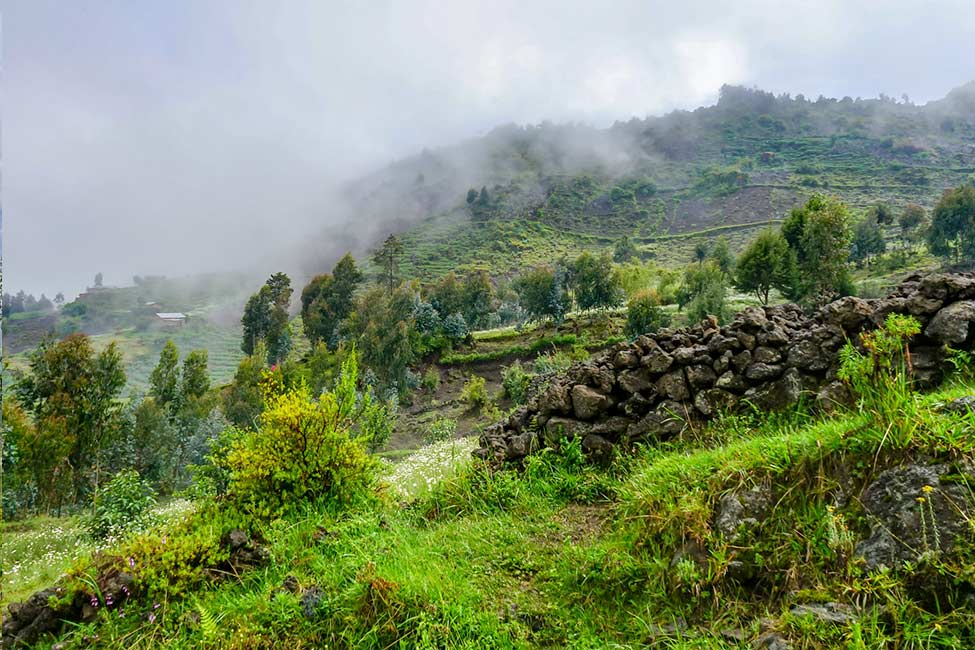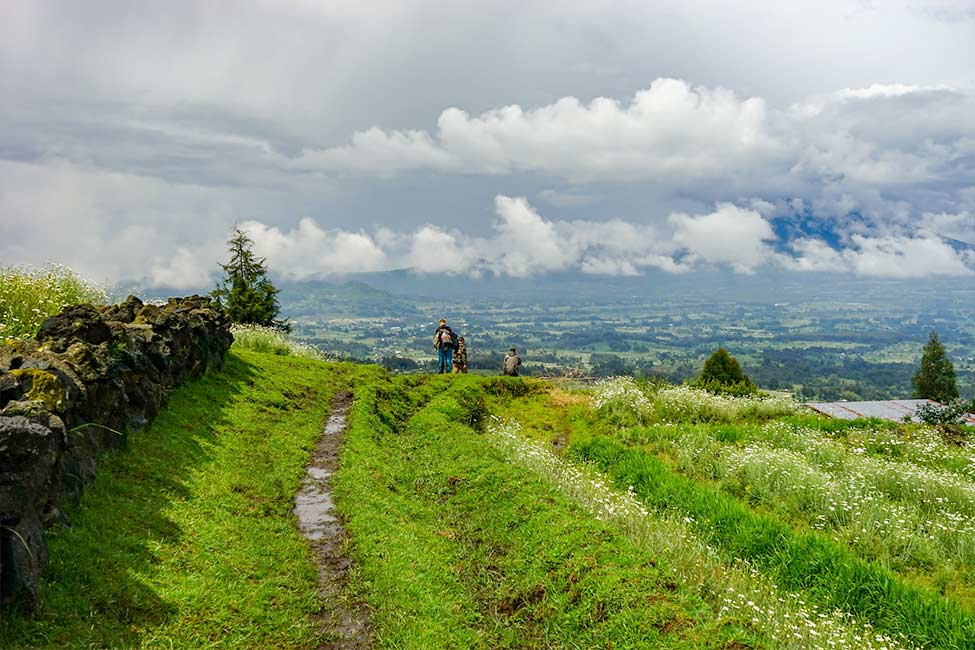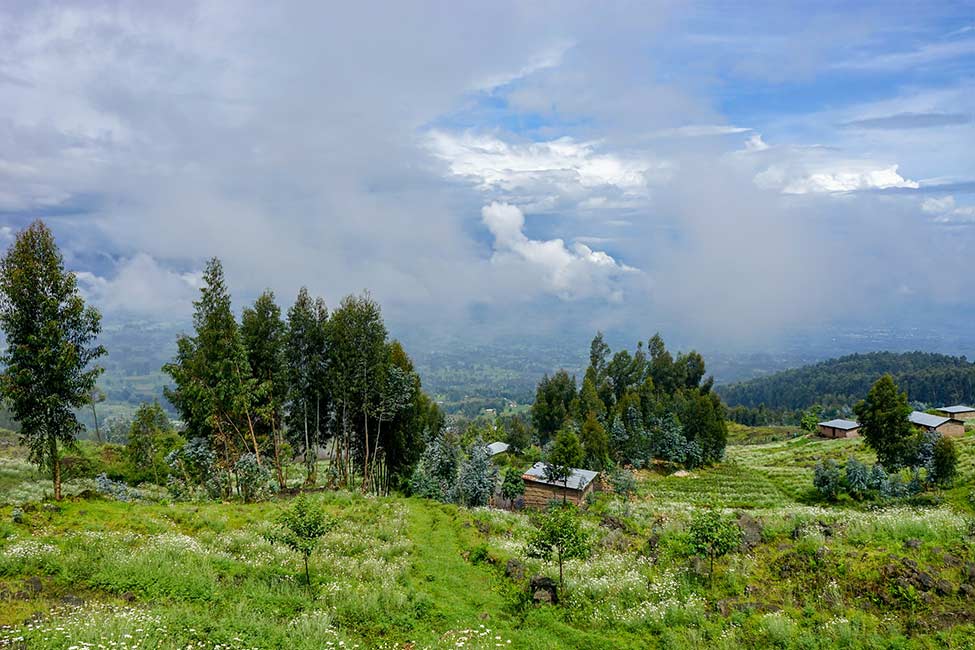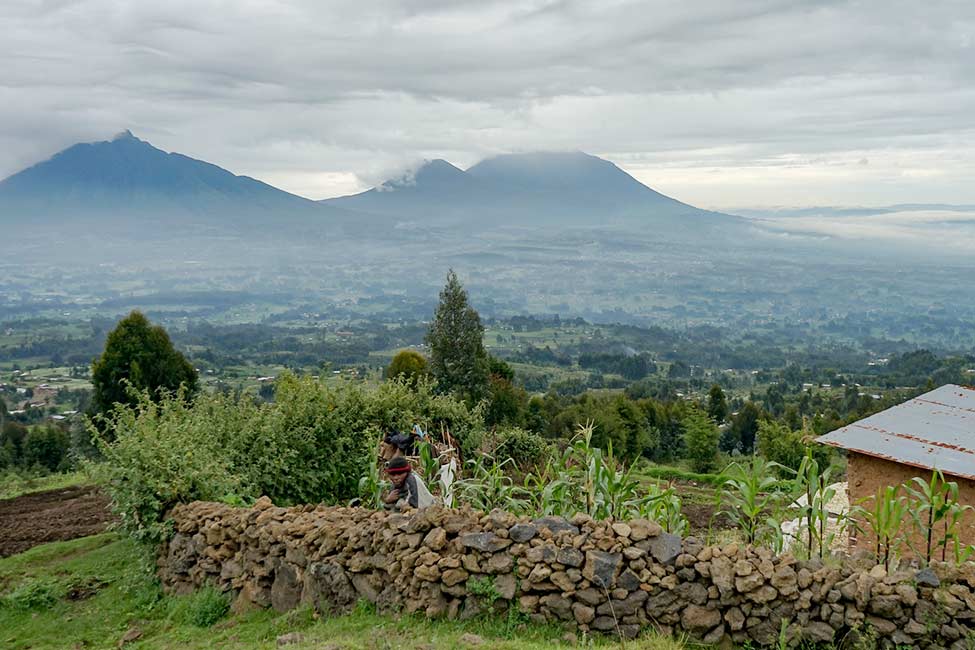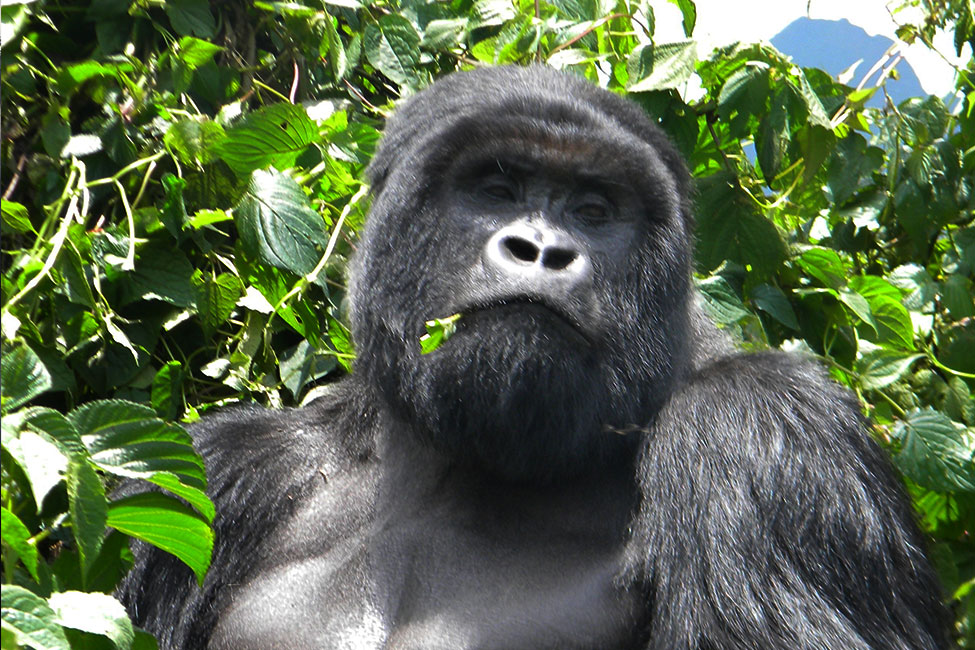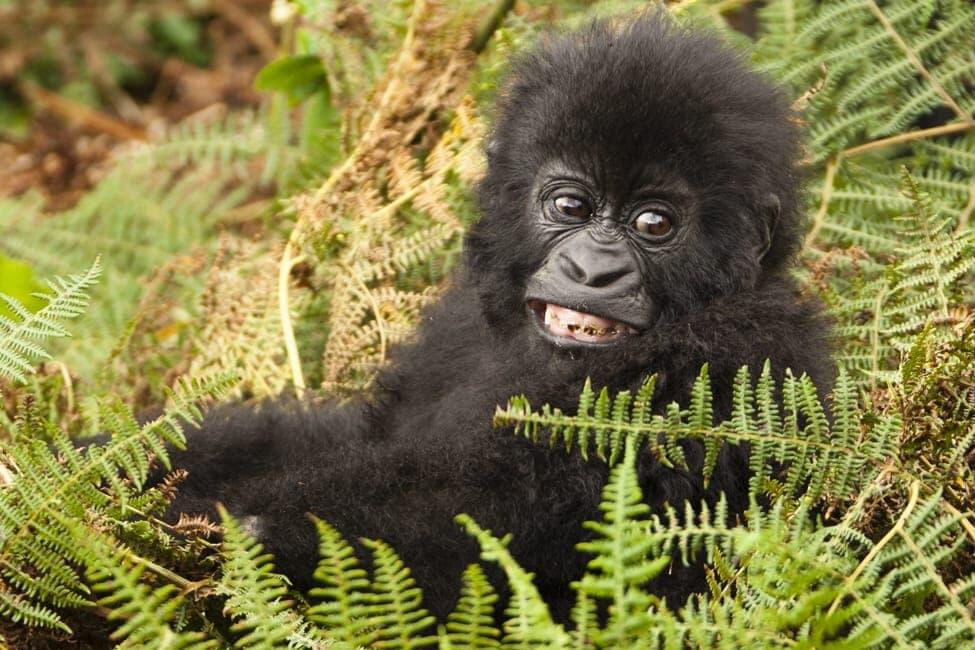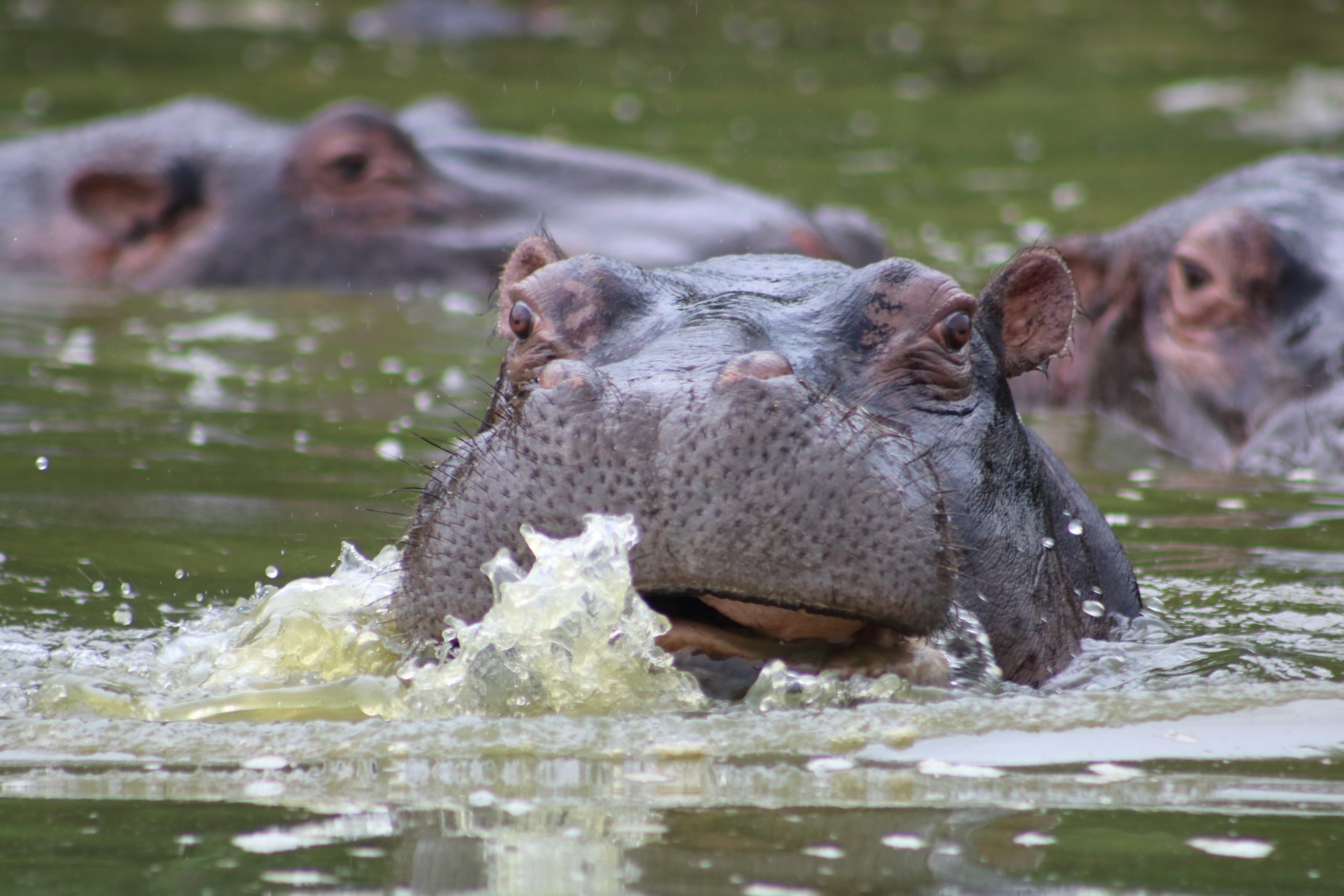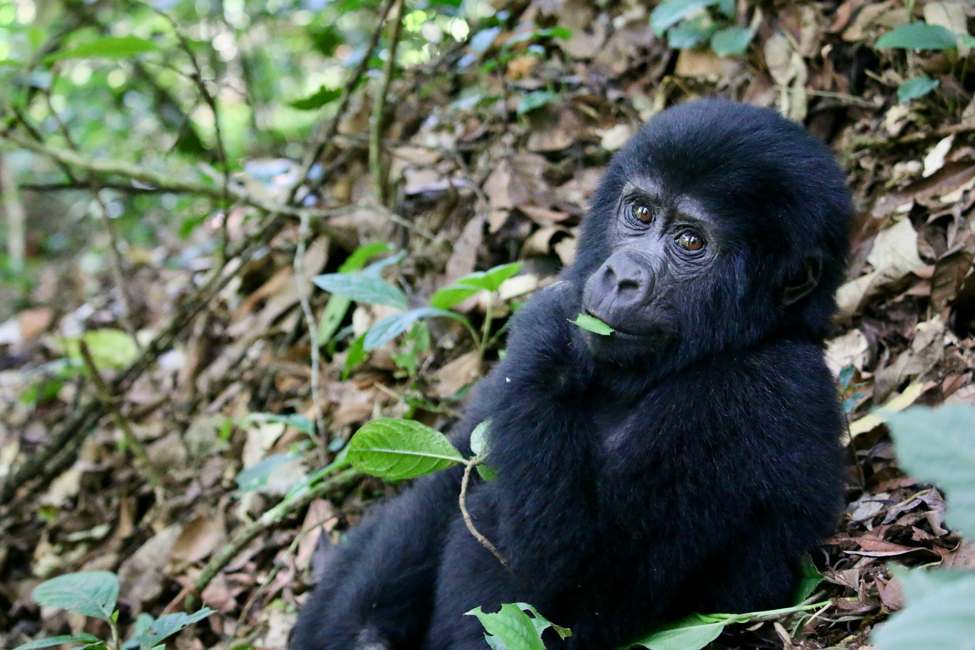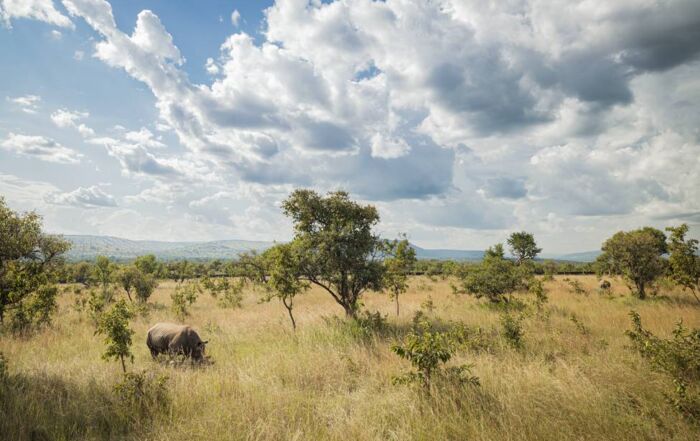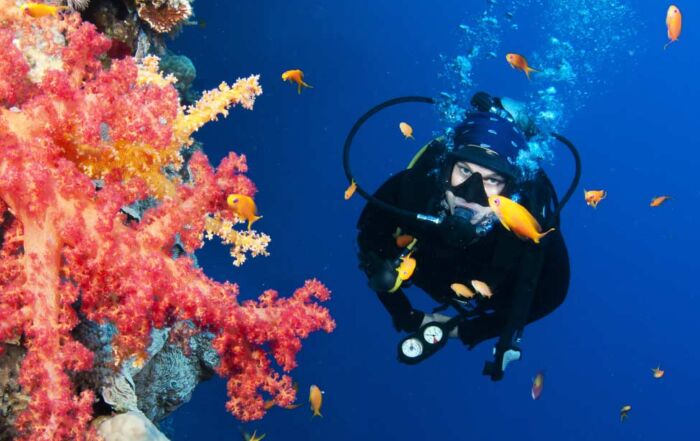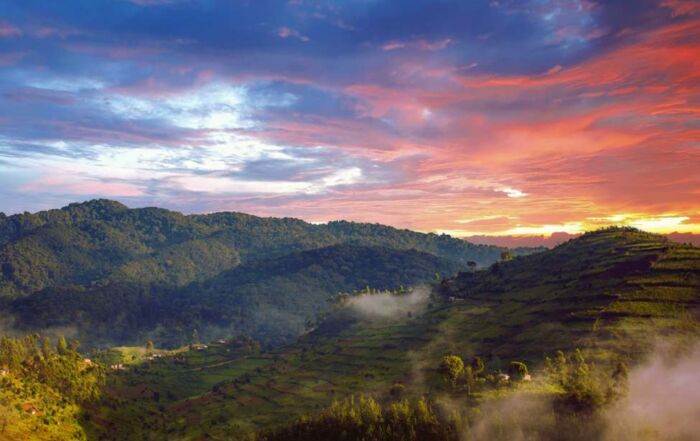This young gorilla is part of a group known as the Kwitonda family—one of the largest mountain gorilla families in Rwanda. Photo credit: Visit Rwanda
Your Complete Guide to Mountain Gorilla Trekking
After trekking through forested mountains, you see them up ahead: dark shadows moving through the bamboo. Mixed in with the sound of rustling leaves, you hear murmuring that is almost human. Your group follows the noise to a clearing.
You have been preparing for this moment, but the emotion you feel is more profound than you imagined. You notice a pair of mothers feasting on bamboo shoots as their children romp around in the leaves. Farther off, a towering silverback allows himself to be groomed by another gorilla as he chews a large leaf.
You watch the scene in awe, touched by how familiar the laughs of the young ones and the watchful faces of the parents seem. And then one of the mountain gorillas turns and looks at you.
Seeing mountain gorillas in the wild is one Ujuzi’s top 10 things to do in Africa. Gorillas and humans have much in common, including close family bonds and insatiable curiosity. But while humans cover the globe, mountain gorillas are endangered, with only about 1,000 mountain gorillas left in the wild.
Mountain gorilla treks give you an unparalleled window into the lives of these creatures. They also play a crucial role in protecting mountain gorillas from extinction.
This article answers:
- Why mountain gorillas are so amazing
- What is a mountain gorilla trek
- Where to go on a mountain gorilla trek
- What you should expect on a gorilla trek
- The best time of year for a mountain gorilla trek
- How mountain gorilla trekking helps protect endangered species
- How to plan a mountain gorilla trek
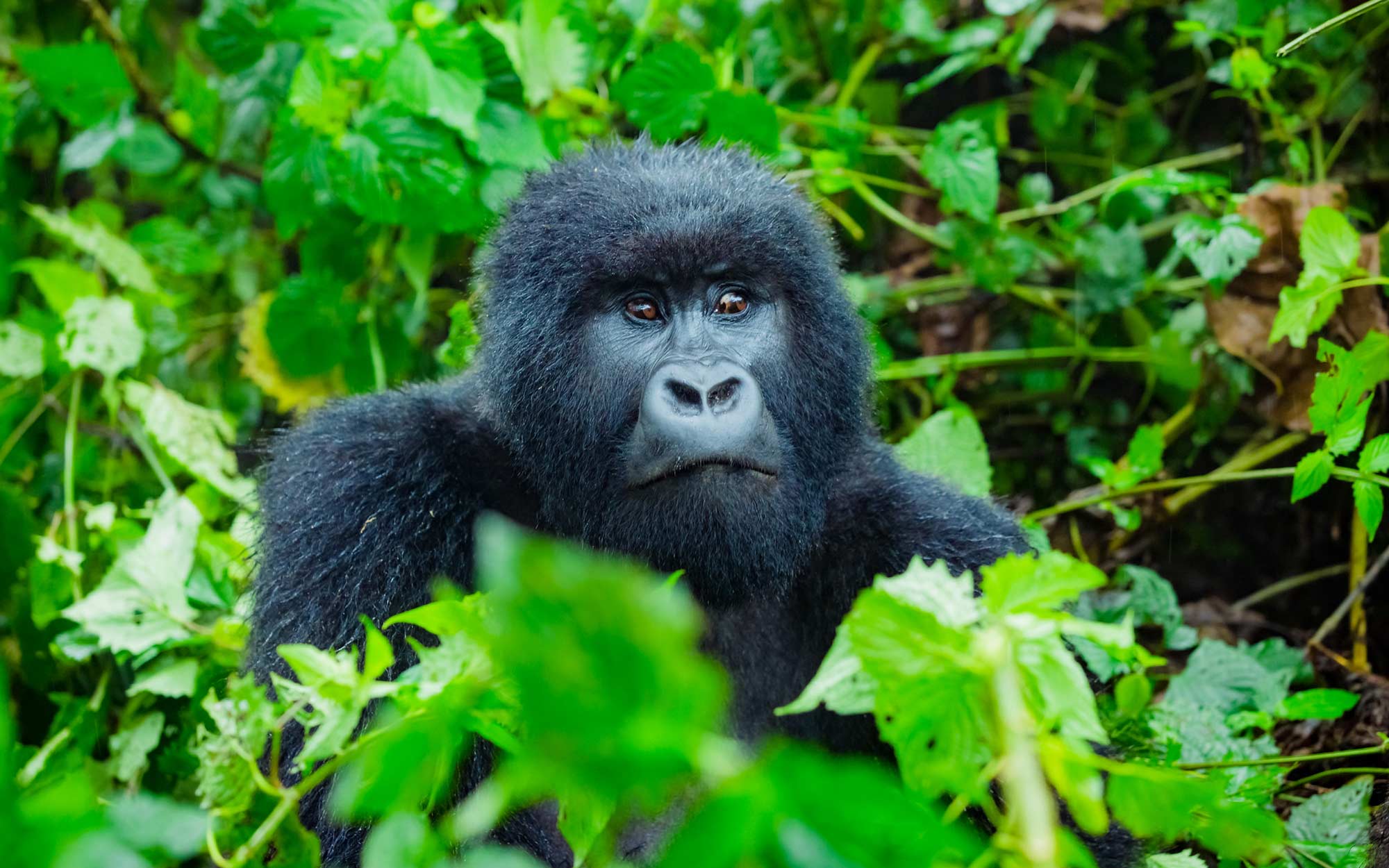
Like other mountain gorillas, this individual shares 98% of its genes with humans. Photo credit: Visit Rwanda
What’s So Special About Mountain Gorillas?
Along with chimpanzees and bonobos, gorillas are among humans’ closest surviving relatives. In fact, humans and gorillas share about 98% of our genomes. Since the 1950s, scientists have studied mountain gorillas to better understand primate behavior.
Mountain gorillas are one of the four main types of gorillas alive today, and the second rarest. Like all great apes, mountain gorillas are endangered.
“When we saw them grooming and eating and just walking around us—it was almost as if my mind could not comprehend the depth of the experience. ‘Moving’ is not even the word. It was a profound spiritual engagement with God’s world and his creatures. It was unbelievable. There was a sense of being at peace together.”
—El Nault, Ujuzi traveler
Because scientists have studied mountain gorillas for so many decades, some families of mountain gorillas are used to humans. Naturalists call these families “habituated.” This means the gorilla family is in the “habit” of seeing humans in non-threatening situations. These families are still wild but do not mind the presence of humans—as long as the humans keep a respectful distance and don’t do anything menacing.
This special situation means that travelers can safely see mountain gorillas in the wild!
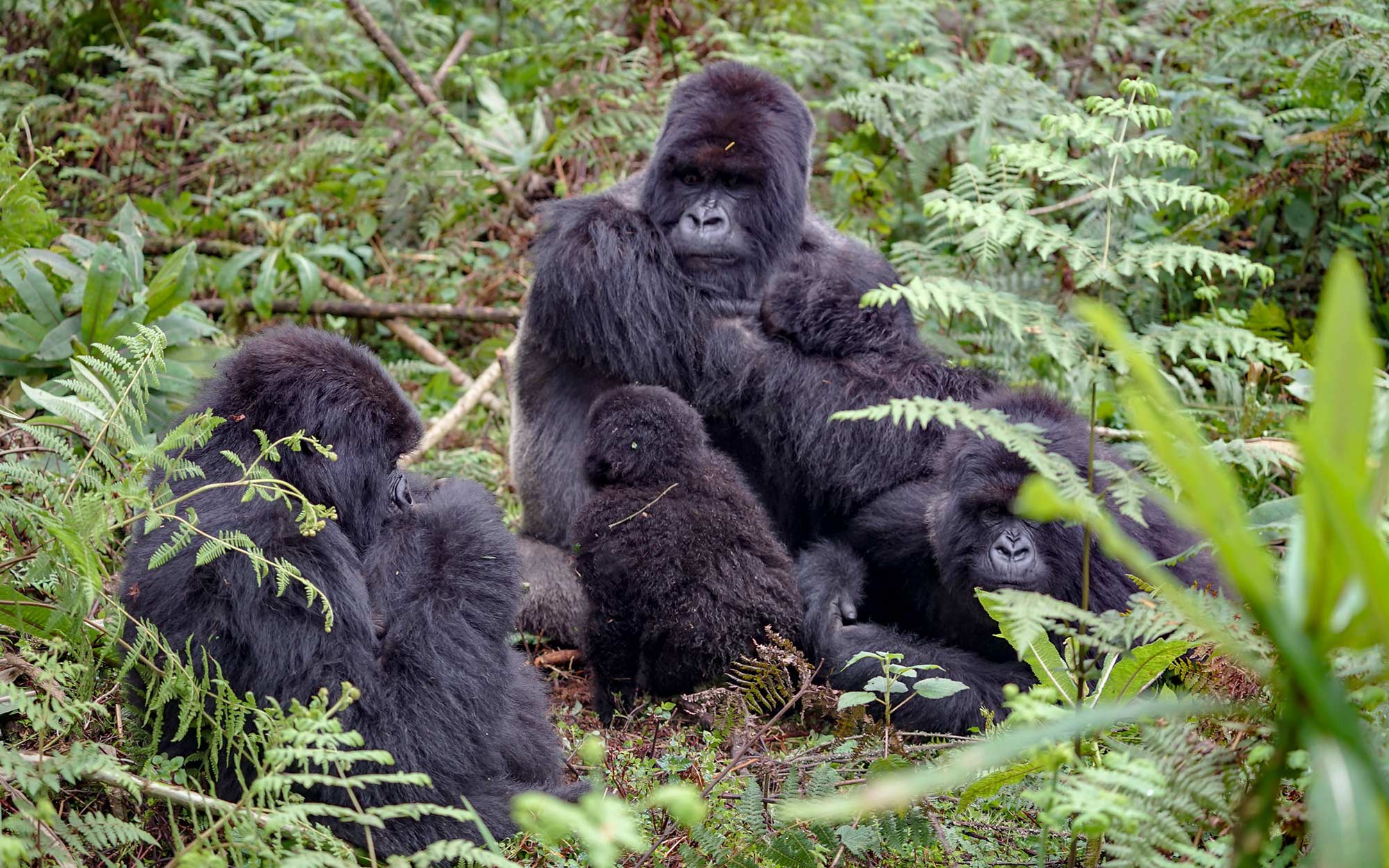
A gorilla family relaxes in Volcanoes National Park, Rwanda. Photo credit: Nina R
What is a Mountain Gorilla Trek?
A mountain gorilla trek is a special kind of walking safari: a guided hike in search of a habituated mountain gorilla family.
Mountain gorillas don’t build their schedules around people. They sleep in a different place every night and travel throughout the day, pausing occasionally to eat and rest. You may need to hike for a few hours to find them.
Once your group catches up with the mountain gorilla family, you spend about one hour observing them. Family groups range from about eight to forty individuals, so you will have a lot to watch!
You never need to worry about overcrowding on a mountain gorilla trek. National parks control the number of tourists by requiring gorilla trekkers to purchase permits. Only a limited number of permits is available each day. These are purchased prior to your trip.
The landscape is breathtaking as you trek your way to an intimate experience with mountain gorillas. All images photo credit: Nina R.
Where Can I Go on a Mountain Gorilla Trek?
Mountain gorillas live in a small area near the shared borders of Uganda, Rwanda, and Democratic Republic of Congo in east-central Africa. Ujuzi offers mountain gorilla trekking at:
- Bwindi Impenetrable National Park, Western Rift Valley, Uganda
- Mgahinga Gorilla National Park, Virunga Mountains, Uganda
- Volcanoes National Park, Virunga Mountains, Rwanda
Bwindi Impenetrable National Park
The largest of the three parks at about 124 square miles, Bwindi Impenetrable National Park in Uganda is home to about 45% of the world’s mountain gorillas. Scientists believe the Bwindi Forest mountain gorillas may be a subspecies, Gorilla beringei bwindi, that is different from the mountain gorillas of Mgahinga and Rwanda.
Gorilla Treks
As of early 2022, Bwindi boasts 18 habituated gorilla families. Bwindi offers traditional mountain gorilla trekking, which allows visitors to spend one hour observing a mountain gorilla family group.
Our Pearl of Africa safari features a Bwindi gorilla trek.
Habituation Experiences
It also offers habituation experiences. These allow travelers to accompany a naturalists to a mountain gorilla group in the process of being habituated. Once you reach your family, you will spend a full four hours observing them. Because you’re spending more time with them, you’re more likely to witness some interesting or unique moments. Throughout your experience, you’ll get insight into gorilla biology, their social structures, and the ongoing habituation process.
Check out our Uganda Great Ape & Wildlife Safari sample itinerary for more about the habituation experience.
Visiting Bwindi
Bwindi Impenetrable National Park is about a ten-hour drive from Kampala, and nearby airstrips can also be accessed by chartered plane from Entebbe. While you’re staying there, take the time to learn about the fascinating local cultures, such as the forest-dwelling Batwa and the agricultural Bakiga communities.
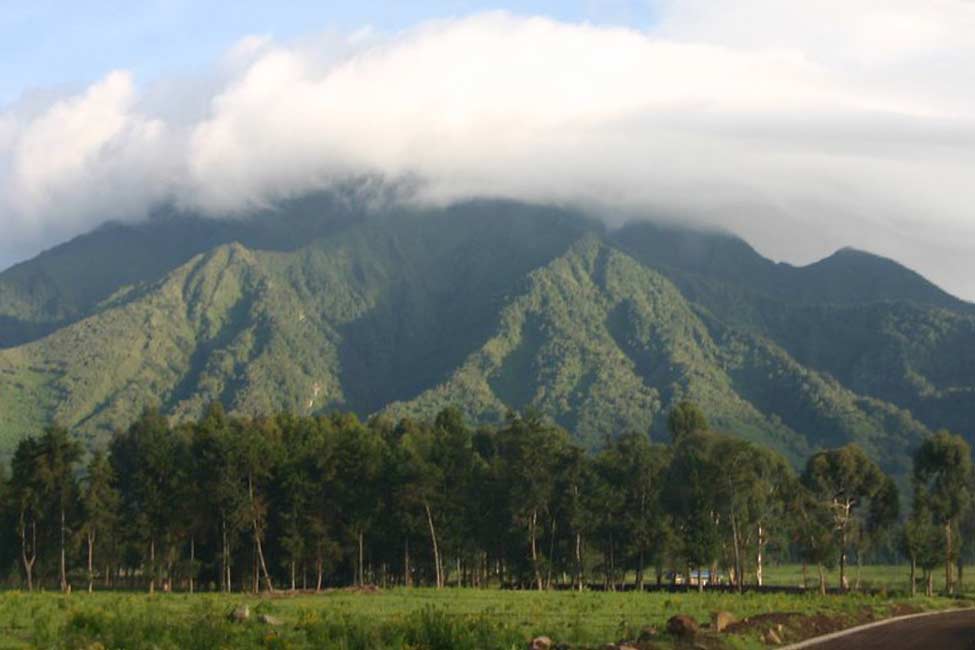
Mountains enshrouded in mist, Volcanoes National Park. Photo credit: Derek Keats
Volcanoes National Park
Volcanoes National Park in Rwanda is about half the size of Bwindi, but home to a large number of habituated gorilla families—11 families in early 2022. Of the mountain gorilla parks, it is the easiest to get to, since it is relatively close to an international airport. This makes it a top choice for travelers who have enjoyed a safari elsewhere in Africa and want to add a few days searching for mountain gorillas.
Multiple park entrances mean the hike to find mountain gorillas is typically shorter than in Uganda. However, Rwanda gorilla trekking permits cost more than double Ugandan gorilla trekking permits.
Explore our sample Rwanda mountain gorilla trekking itinerary.
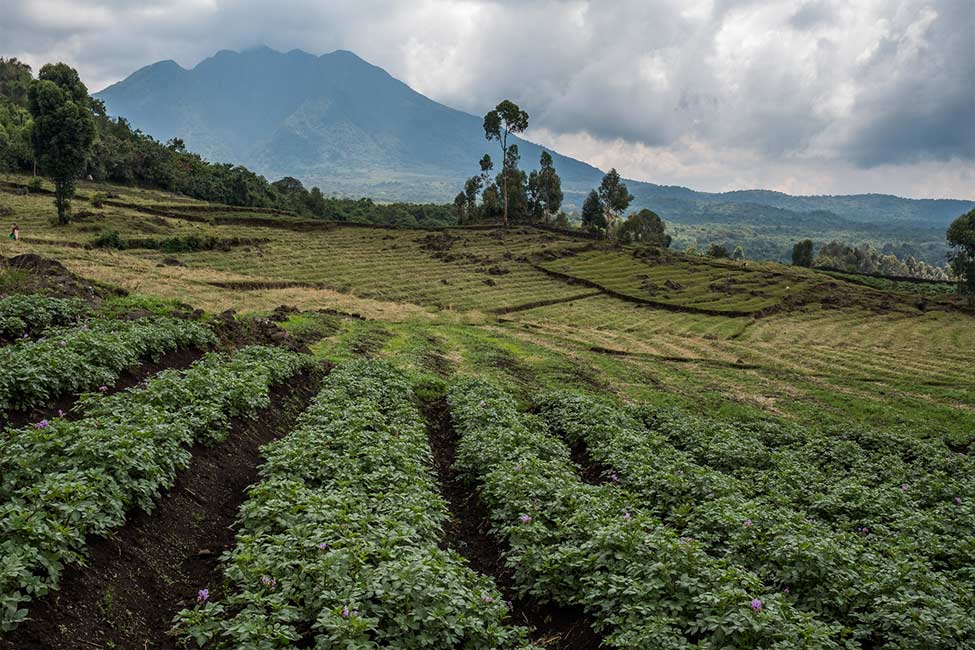
Agricultural fields border Mgahinga Gorilla National Park. Photograph by Jason Houston for USAID Diversity & Forestry
Mgahinga Gorilla National Park
Mgahinga Gorilla National Park in Uganda is the smallest of the three parks. It is about 13 square miles and has one habituated family group, the Nyakagezi family. Because of this, Mgahinga Park attracts fewer tourists. Travelers looking for more privacy and a real escape from the world will appreciate this aspect of Mgahinga.
Another perk of the park’s small size is that the family group here is generally easier to track. In years past, there were some issues with the Nyakagezi family crossing the border into Rwanda or DRC, but lately, it has preferred to stay close to home.
What Should I Expect on a Gorilla Trek?
On the morning of your trek, your guides meet you at park headquarters and explain the rules of mountain gorilla trekking. These include keeping a safe distance from mountain gorillas and how to behave near mountain gorillas.
You will have several guides and trackers. Some will stay with your group, leading you to the last place your mountain gorilla family was last seen. Others will move ahead, looking for the family’s current location. They will radio any important information to your group.
The ground is uneven, and you will go off the beaten path. A walking stick is provided with your permit—use it! We strongly recommend hiring at least one porter. Porters can help carry your belongings and guide you over difficult terrain. They make your journey easier, and you can learn a lot from talking with them. You will also be contributing toward a critical source of community income. (Check out our guides to tipping and using local African currencies for more information.)
It can take anywhere from one to six hours to find a mountain gorilla family. It is very rare that gorilla trekkers do not catch up with their group eventually. In all our years of offering gorilla treks, Ujuzi has never had a client miss seeing these animals.
The pursuit is part of the magic of a gorilla trek. It gives you time to appreciate the surrounding forest. Enjoy the journey, fuel up on snacks, and ask your guides about anything that piques your interest.
When you reach your mountain gorilla family, you forget any fatigue from the hike. We could go on and on about how amazing this experience is, but we think Ujuzi traveler El Nault summed it up best:
“When we saw them grooming and eating and just walking around us—it was almost as if my mind could not comprehend the depth of the experience. ‘Moving’ is not even the word. There was a sense of being at peace together.”
—El Nault, Ujuzi traveler
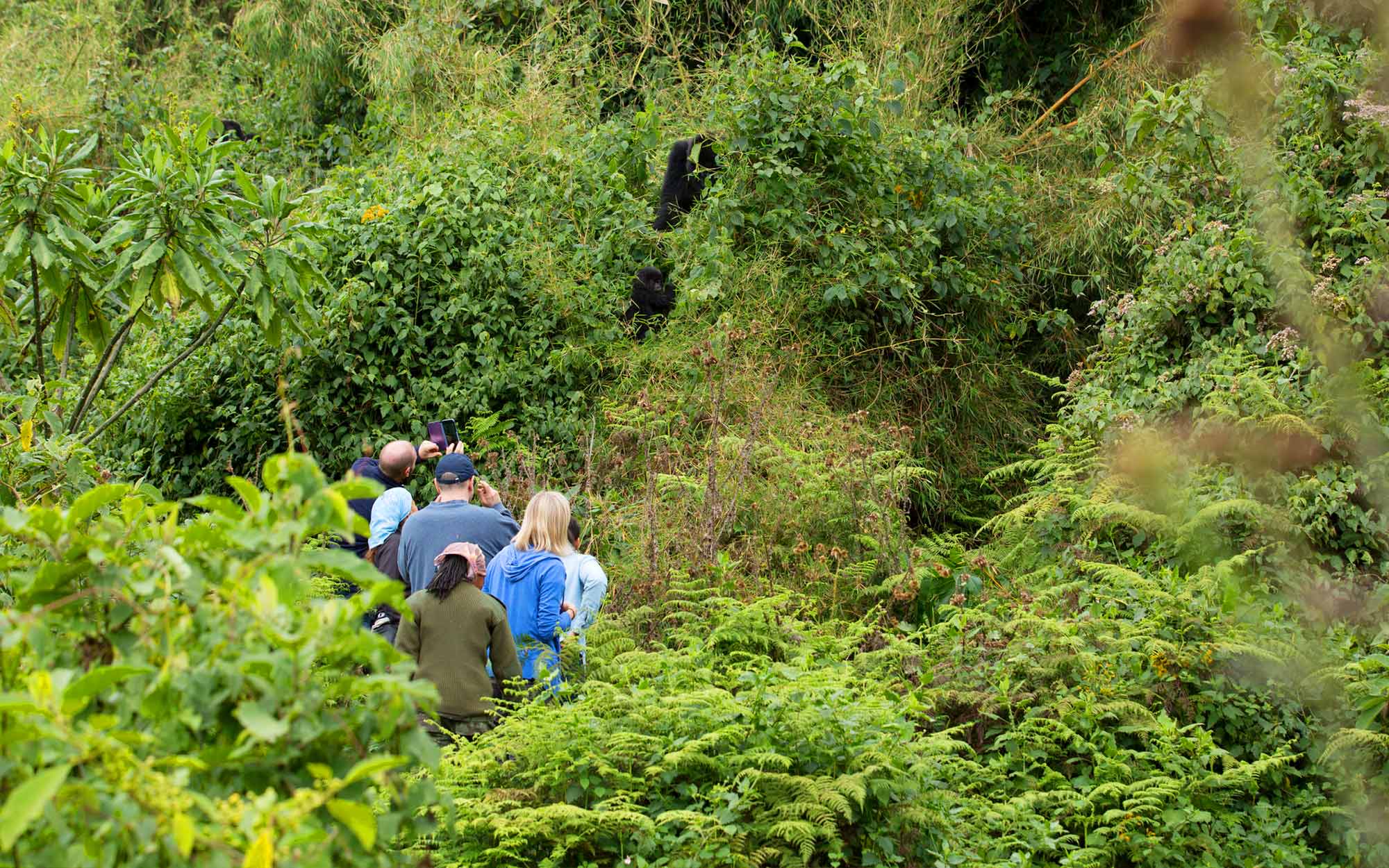
Travelers watch young gorillas climb a dense thicket of bamboo and vines, Volcanoes National Park, Rwanda. Photo credit: Ministry of Environment
Do I Need to Be in Good Shape for a Gorilla Trek?
Porters can assist people with physical limitations, but most travelers should expect to walk several hours during a gorilla trek. You will be hiking in uneven mountainous terrain up to 7,000 feet in elevation. Trails may be narrow or non-existent.
We recommend getting your doctor’s okay before planning a mountain gorilla trek. Then, prepare for your trek with a regular walking regimen in the months before your trip. Seek out trails and hilly areas. On a treadmill, use a variety of incline settings to get used to walking uphill.
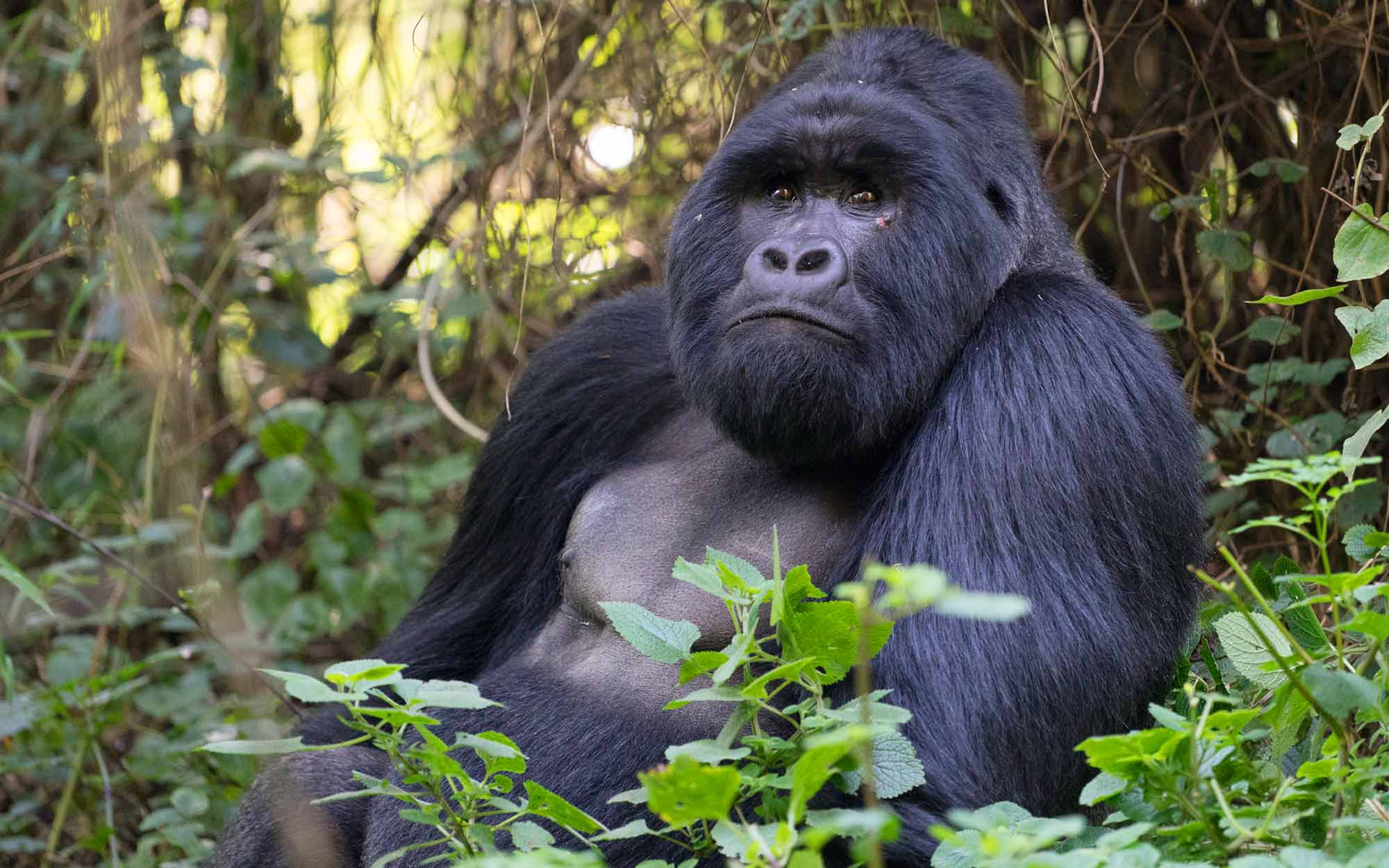
An adult mountain gorilla takes a rest at Mgahinga Gorilla National Park, Uganda. Photo credit: Nina R
What Time of Year Should I Go?
Mountain gorilla trekking can occur year-round. When to go is determined by your schedule and personal preferences about weather.
This area of the world has wet and dry seasons. The dry seasons take place in summer and winter, with temperatures ranging from about 50ºF in the morning up to 85°F in the afternoon. The wet seasons are in spring and fall, and temperatures tend to be milder. While rains are concentrated in the wet season, dry days can occur then, and rains may occur in the dry seasons.
The wet season rains are not heavy enough to prevent hikes, but trekkers should be prepared for mud and slippery surfaces. The plus side of a wet season visit is that the parks tend to be less busy those times of year. Some lodges even offer wet-season discounts!
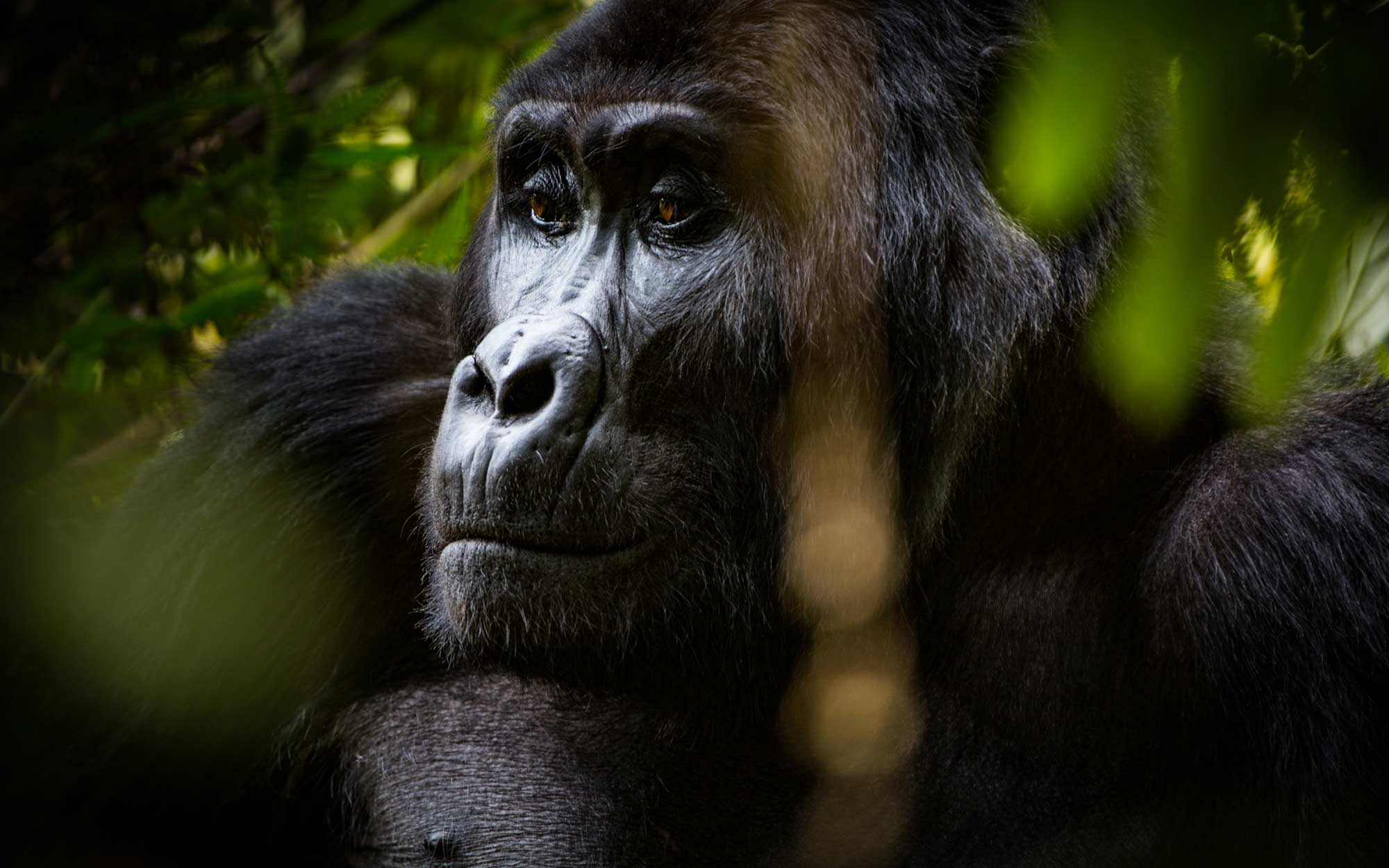
This individual is a member of the Rushegura group, one of the first mountain gorilla families habituated to trekking in Bwindi Impenetrable National Park, Uganda. Photograph by Jason Houston for USAID
How Do Mountain Gorilla Treks Protect Threatened Species?
Through the end of the twentieth century, mountain gorillas were critically endangered. Thanks to the concerted efforts of African conservationists, their population has slowly increased over the past few decades and they were upgraded to “endangered” in 2008.
Mountain gorilla trekking plays an enormous role in ensuring this positive trend continues.
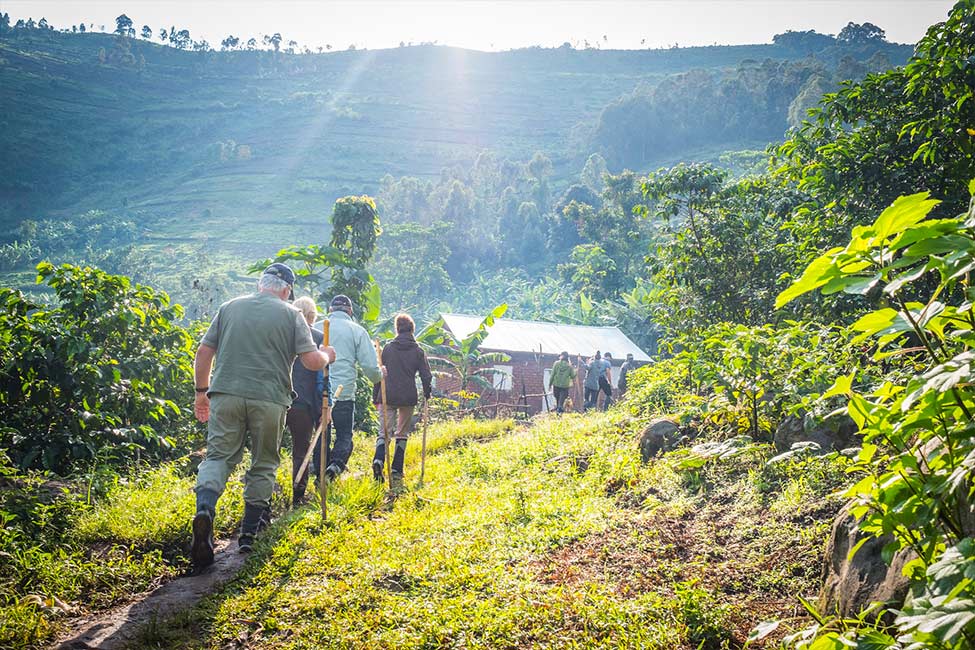
Travelers set out to find a mountain gorilla family in Bwindi Impenetrable National Park, Uganda. Photo credit: Jason Houston for USAID
A Natural Life for Mountain Gorillas
Trekking permits prevent stress on mountain gorillas by limiting the number of humans moving through the parks, strictly regulating interactions with mountain gorillas, and prohibiting visits to mountain gorillas that feel threatened by humans. These policies create an environment where mountain gorillas can carry out their lives in a way that is natural for them.
Protecting the health and welfare of these animals is the number-one priority. To prevent the spread of respiratory diseases from humans to mountain gorillas, a number of rules are in place. You must have no symptoms of contagious illness, wear an approved mask during viewing, and keep 10 meters (32 feet) away from the gorillas at all times. Parks may also require a negative COVID-19 test for entry. When you travel with Ujuzi, we’ll let you know the current requirements and help you make any necessary arrangements for testing.
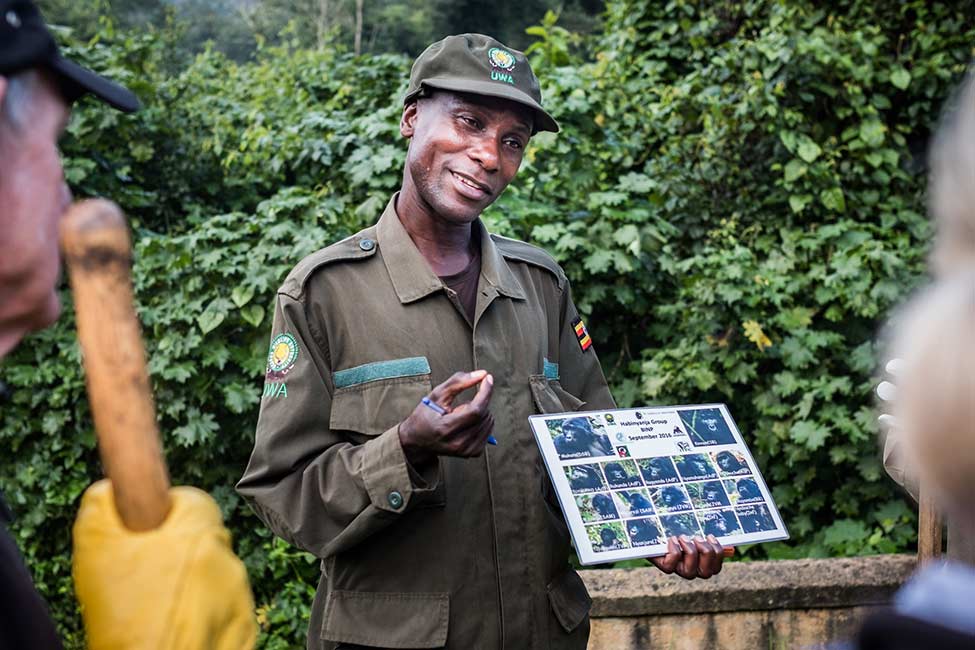
David Agenya, head ranger at the Buhoma Headquarters of Bwindi Impenetrable National Park, meets with travelers before their gorilla trek. Photo credit: Jason Houston for USAID
Contributions to Science
Gorilla trek guides provide important information for conservation, including population numbers and observations about gorilla behavior. They report concerns about gorilla health to wildlife veterinarians, who can provide treatment if necessary.
Encouraging Conservation
The presence of tourists and wildlife workers discourages poaching, illegal logging, and other activities that would harm mountain gorillas and other threatened species in the parks.
Tourism money enhances this effect. When tourists spend money in local communities, they help the economic desperation that can lead to habitat and wildlife destruction. A portion of park fees pays for community projects to improve education, income, healthcare, and other crucial resources in the surrounding area. Additional money comes in the form of employment at lodges and other venues visited by tourists, as well as gratuities to guides, trackers, porters, and lodge staff.
Bwindi Impenetrable National Park, Volcanoes National Park, and Mgahinga Gorilla National Park would not exist as the thriving ecosystems they are today without the income from mountain gorilla trekking. Permit fees pay for park staffing, management, and infrastructure—protecting the land and, therefore, the mountain gorillas who make it their home.
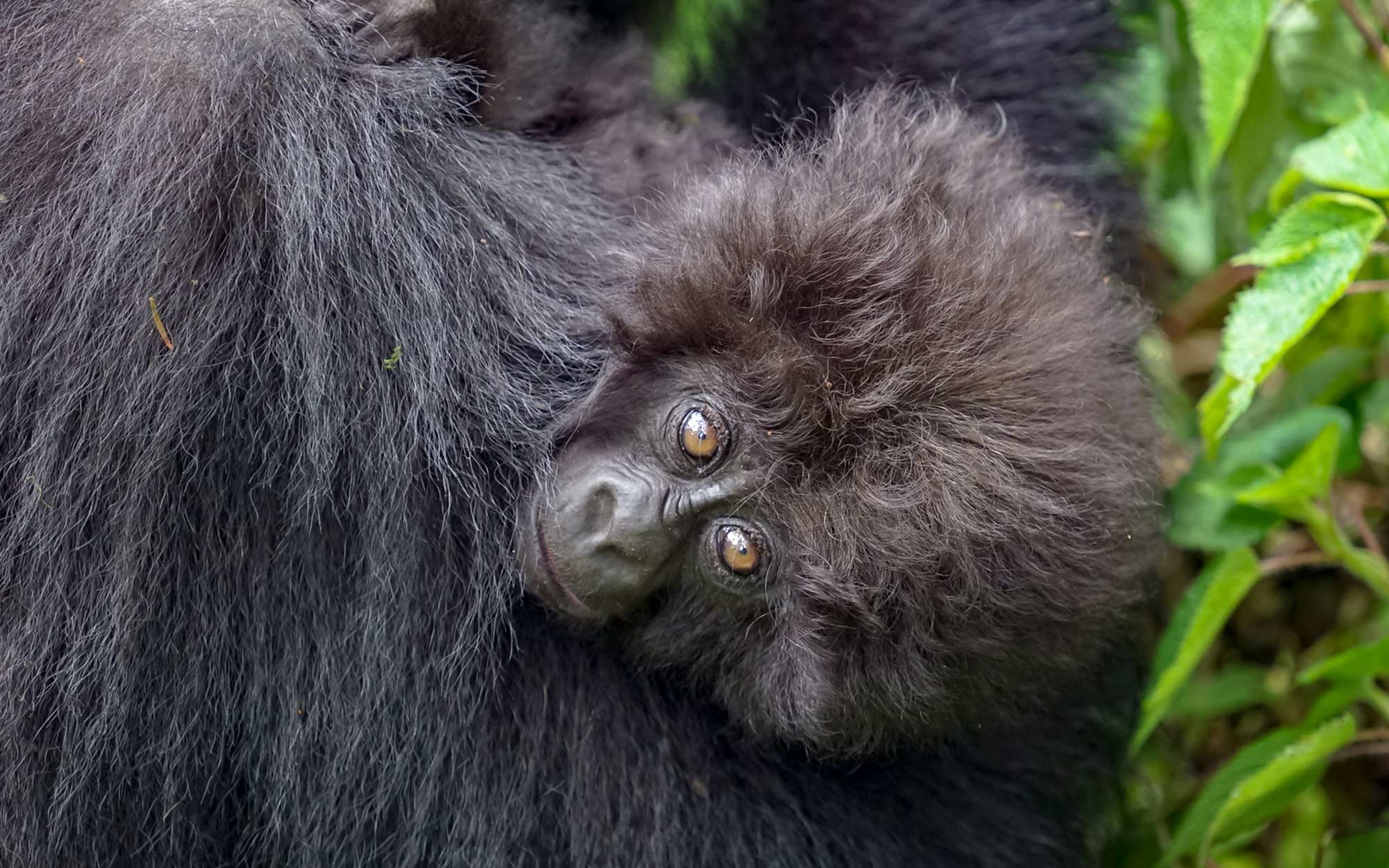
A baby mountain gorilla looks up from its mother’s arms, Volcanoes National Park, Rwanda. Photo credit: Nina R
How Do I Plan a Mountain Gorilla Trek?
Planning a mountain gorilla trek involves a lot of details. You will need to decide which park(s) to visit, get permits, reserve lodgings, arrange transportation and guides, and decide what to pack. Ujuzi African Travel can make this process simple by making all the arrangements for you based on your preferred dates, other wildlife you’d like to view during your visit, and the types of lodging you’d like to experience.
Take a journey like no other. Contact us today so we can create the safari of your dreams.
Pin This Post & Save for Later!
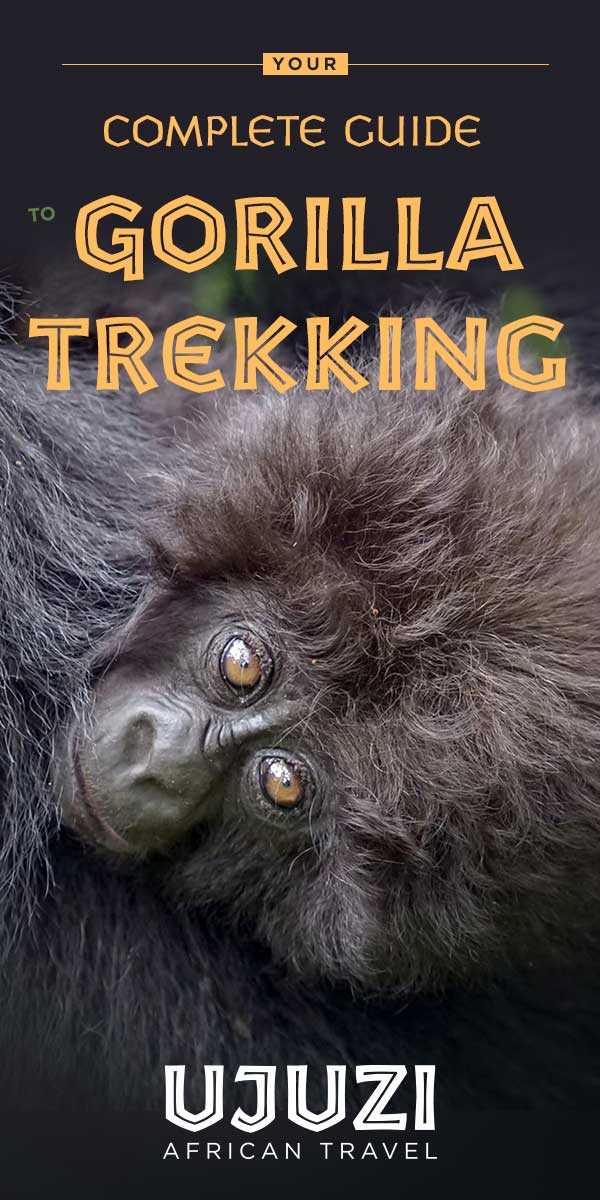
Sign up for the Ujuzi Newsletter!
From top travel tips to innovative safaris and conservation movement, get inspired to plan your next African safari!
By submitting this form, you are consenting to receive marketing emails from: . You can revoke your consent to receive emails at any time by using the SafeUnsubscribe® link, found at the bottom of every email. Emails are serviced by Constant Contact


